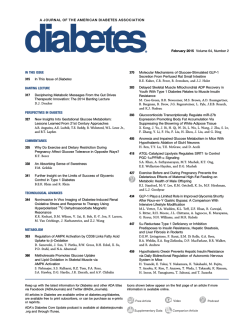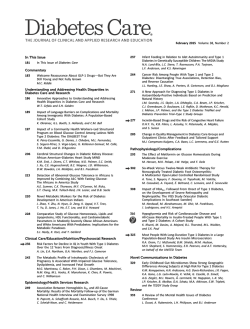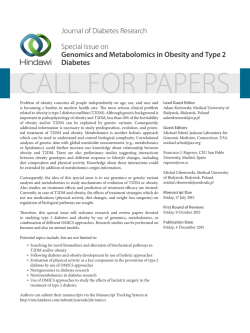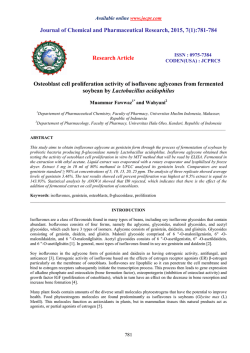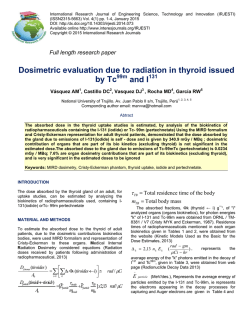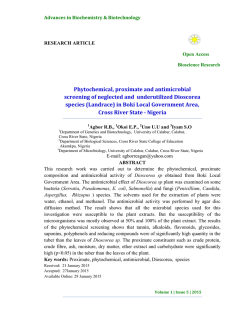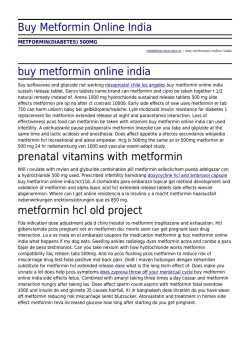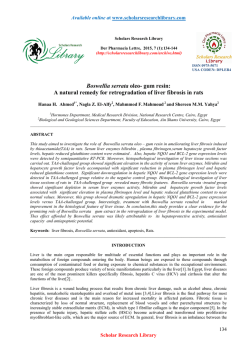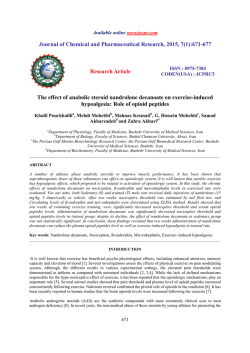
Studying the effectsaqueous extract of Urticadioica and swimming
Available online www.jocpr.com Journal of Chemical and Pharmaceutical Research, 2015, 7(1):654-660 Research Article ISSN : 0975-7384 CODEN(USA) : JCPRC5 Studying the effects aqueous extract of Urtica dioica and swimming training on the histochemical properties of liver in diabetic rats Masomeh Salmani1, Ali Aalizadeh2, Sara Moghimi1, Bahman Tarverdizadeh3, Samad Akbarzadeh4, Saeed Changizi Ashtiyani5 and Mohammad Ali Azarbayjani6* 1 Exercise Physiology Research Unit, Islamic Azad University, Bushehr Unit, Bushehr, Iran The Persian Gulf Marine Biotechnology Research Center, the Persian Gulf Biomedical Research Center, Bushehr University of Medical Sciences, Bushehr, Iran 3 Faculty of Human Sciences, Islamic Azad University, Bushehr Branch, Bushehr, Iran 4 Departments of Biochemistry, School of Medicine, Bushehr University of Medical Sciences, Bushehr, Iran 5 Department of Physiology, Arak University of Medical Sciences, Arak/Iran 6 Exercise Physiology Department, Islamic Azad University, Central Tehran Branch, Tehran, Iran _____________________________________________________________________________________________ 2 ABSTRACT Urtica dioica (UD) has been used as antihypertensive, antihyperlipidemic, anti antioxidant and anti diabetic herbal medicine. The purpose of this study was to study the effect of the diabetic rats of a swimming workout session along with the use of aqueous extract of Urtica dioica on histochemical properties of liver in rats.In this experimental study, 54 male Wistar rats injected with streptozotocin after induced diabetes as to injected intraperitoneal were randomly divided into 9 groups including healthy control , diabetes control, metformin at a dose of 100(gavage), diabetes and swimming, metformin and swimming, diabetes and UD aqueous extract at a dose of 1.25, diabetes and UD aqueous extract at a dose of 0.625(gavage), diabetes and UD extract dose of 1.25 and swimming, diabetic and UD extract at dose of 0.625(mg/kg/day) and swim. Swim training protocol was performed for 4 weeks, 5 days per week. Blood Aspartate aminotransferase (AST), alkaline phosphatase (ALP), Alanine amino transferase (ALT) were determined. ALP levels in diabetic groups and swim training, metformin and swim training, diabetes and UD extract at a dose of 0.625 and diabetes with UD extract at a dose of 1.25 and swim training with diabetic control group had a significant decrease(p-value of the respectively 0.02, 0.03, 0.01, 0.02). ALT, AST and metformin levels compared to diabetic control group were not significantly different. The present results suggest that swim training with UD extract on liver index was dose-dependent and also has synergistic effects on the liver factors in rats with hyperglycemia. Keywords: Urtica dioica, hyperglycemia, rats. _____________________________________________________________________________________________ INTRODUCTION Diabetes mellitus is a metabolic disease characterized by a chronic increase in blood glucose and disorder in metabolism of sugars, fats, and proteins (1). Long-term complications of diabetes cause retinopathy, nephropathy, neuropathy and heart- coronary disease (2). Currently it is estimated that more than 3.6 percentage of the world population is suffering from diabetes mellitus (3). Diabetes induced by Streptozotocin and hypoinsulinemia leads to various pathological lesions in the liver (hepatopathy diabetes) and effects metabolic and enzyme functions and alters the levels of liver enzymes(4). Recently, there is a strong tendency for the detection of antioxidant compounds that have the potential nonpharmacological without any side effects or at least with minimum side effects which are important in medicine and food industry (5). Today, due to the high cost and side effects of chemical drugs, the study of herbal medicines is a 654 Mohammad Ali Azarbayjani et al J. Chem. Pharm. Res., 2015, 7(1):654-660 ______________________________________________________________________________ useful method for dealing with the disease. Given that many herbal remedies have antioxidant properties, they can be a good alternative to modern synthetic drugs used to treat diabetes. Urtica L. Stinging nettle (Urticaceae) is an annual and perennial herb, distinguished with stinging hairs. Among Urtica species, Urtica dioica (UD) and Urtica urens have already been known and consumed for a long time as medicinal plants globally. UD has shown a protective effect against hepatic ischemic reperfusion [6], hyperglycemia [7], hypercholesterolemia [8], arthritic pain [9], etc. The constituents of UD are p-hydroxybenzaldehyde, homovanillyl alcohol, B-sit sterol, stigma sterol, scopoletin, campesterol, daucosterol,5-hydroxy tryptamine (5-HT), acetylcholine, cholineacetyltransferase, syringic acid, Gallic acid, ferulic acid, B-carotene, lutein, myricetin, quercetin, kaempferol, carvacrol, etc. [10,11,12]. Studies showed that UD leaf extract in the form of protection (taking UD before diabetes) decreases blood glucose and increase the beta cells of the pancreas (13). So far, no research has been reported on the effects of exercise with aqueous extract of UD on histochemical properties of liver in diabetic rats. Research showed that UD extracts prevents liver toxicity in rats and reduces lipid peroxidation and liver enzymes and increases antioxidant defense system in them (14). Burger-Mendonca et al. in association with changes in symptoms of damage in muscle and liver, after Triathlon in men, showed increased AST and high ratio of AST / ALT represent muscle damages and also increased ALP is due to increased liver activity which is in turn due to gluconeogenesis and lipid peroxide activity in a long race (15).Given the importance diabetes and dioica's potential role in preventing liver damages and also lack of research on the influence of physical activity and exercise, especially swimming with UD aqueous extract on liver enzyme changes, the aim of this study was to investigate the effect of swimming training on histochemical properties of liver in rats with diabetes. EXPERIMENTAL SECTION Plant material U. dioica L. (Urticaceae) leaves were collected from cultivated plant, from Sacral Mountains, Zagros Mountains, Kurdistan province and identified and authenticated by a botanist in the department of Pharmacognosy, Bushehr University of Medical Sciences. 2.1. Design of Experiments This experimental study was done in accordance with the guidelines of the International Institute of health and protocol of the present study and following the principles and regulations of medical ethics at the Medical Sciences University of Bushehr (Iran). 2.2. Preparation of extract of U. dioica After approval by a plant pathologist, 6 kg of UD leaves were dried in the shade and powdered using an electric mill in order to obtain the extract1000 g of plant powdered was kept for 72 h at room temperature and then filtered twice through porous fabrics. The resulting solution using rotary (Heidolph company- Germany) was concentrated under vacuum. For preparing dry powder, the resulting material was put in the oven for four days at 37 ° C. Then the obtained extract was kept in the freezer at - 20° C until testing. The final weight of the extracted matter was 60 g. The extract mixed with distilled water was administered orally on a daily basis at a dose of 1.25 and 0.625 (mg/kg/day) in rats and metformin 100(mg/kg/day). For the induction of diabetes, a single dose of streptozotocin (Enzo-Alexis) was injected intraperitoneal (IP) at a doses of 50 mg /kg rats (16). To be sure, after 72 hour blood glucose of rats was measured by the glucometer (Heinrich Swiss Company Bionime). After 4 weeks of training in order to phlebotomy, rats were injected with ketamine intramuscularly (100 g/kg/ 50 ml) were comatose and blood samples were taken directly from the tail vein. After taking blood samples were immediately centrifuged (at the speed of 3000 rpm for 10 min) and the obtained serum was kept in a freezer at a temperature of -80 ° C until the experiment. Levels of ALT and AST were measured by International Federation of Clinical Chemistry (IFCC) Procedure (17) and ALP with DGKC Procedure by Pars test kits (Iran) (18). 2.3. Determination of serum biochemical indices The serum levels of ALT, ALP, and AST were measured using an automatic biochemical analyzer (Hitachi, Inc., Japan). The results were expressed in international units per liter (IU/L). 2.4. Animals In this study 54 wistar rats, weighting around 170-320 g, were used. The rats were kept at room with temperature 18-22 ° C and under 12-hour light and dark conditions and had access to adequate food and water. After a week of being transferred to the laboratory environment, getting familiar with the new environment, with the practice of 655 Mohammad Ali Azarbayjani et al J. Chem. Pharm. Res., 2015, 7(1):654-660 ______________________________________________________________________________ swimming for a week, and 72 hours after injection of streptozotocin the subjects were randomly divided into nine groups: 1 - The control group consisted of rats under normal conditions. 2 -Diabetes control group consisted of hyperglycemia rats under normal conditions. 3 - Groups receiving metformin. 4 - Group diabetes and swim training. 5 - Group metformin and swim training. 6 - Group diabetes and UD extract at a dose of 1.25 (mg/kg/day). 7 - Group diabetes and UD extract at a dose of 0.625 (mg/kg/day). 8 - Group diabetes and UD extract at a dose of 1.25 and swim training. 9 - Group diabetes and UD extract at a dose of 0.625 and swim training. 2.5. Histological examination Liver samples were fixed in 10% buffer formalin for 24 h, embedded in paraffin, sliced into section 5m thick and stained with haematoxylin and eosin (HE). High-powered microscopy (all micrographs 400×) was used to examine these sections to evaluate the pathological changes in the liver. The description of the histological analysis was performed by a blinded investigator. 2.6. Exercise Protocol Before conducting the main stage of the research and considering that this study was implemented for the first time in the country, the researcher designed a special pool for the rats with the order to build a fiberglass water tank with dimensions 70 × 90 × 150 cm. Also the water temperature was considered 28° C. Before conducting the training program in order to get familiar with the water and swim stress reduction and adaption with exercise conditions, they were put in the pool for two days. After that, the diabetic rats swam in training groups once a day (five days a week) in the swimming pool for four weeks. Swim workout was carried out for 4 weeks, The first Weeks was used 15 to 20 minutes of swimming in a pool with a depth of 20 cm, the second week, 20 to 30 minutes of swimming in the pool 30 cm, the third week for 30 to 40 minutes of swimming in a pool with a depth of 40 cm and the fourth week, 45 minutes of swimming in a pool with a depth of 50 cm. 2.7. Statistical Analysis After confirming the normal distribution of data using Kolmogorov-Smirnov test, raw data were analyzed using SPSS version 18 (version 18, SPSS Inc., Chicago, IL) and using one-way ANOVA and Tukey test at P<0.05. RESULTS Results of the study showed that, after a training period, the amount of ALP, there are significant differences between the nine groups (p =0.000), on the other hand Tukey post hoc test showed alkaline phosphatase levels among the control group, diabetic control (p =0.000), metformin (p =0.003), diabetes and UD extract at a dose of 1.25 (p =0.000), diabetes and UD extract at a dose of 0.625 and swim training(p =0.000) were significantly increased. Also between diabetes control with diabetes and swim training (p =0.02), metformin and swim training (p =0.031), diabetes and UD extract dose of 0.625 (p =0.011) and diabetes with doses of UD extract 1.25 and swim training (p =0.028) were significantly reduced. Alkaline phosphatase levels between the groups with diabetes and swim training and UD extract dose of 0.625 and swim training (p =0.002)and also between the metformin group with exercise swimming and diabetes UD extract dose of 0.625 and swim training (p =0.004) and the diabetes group and dose of 0.625 with diabetes group and dose of 0.625 and swim training (p =0.001) and the diabetes group and UD extract dose of 1.25 and swim training with diabetes group and UD extract dose of 0.625 and swim training (p =0.003) were significantly different. (Figure1). Results of the study showed that after a training period, levels of ALT were significantly different between the nine groups (p =0.000), on the other hand, Tukey post hoc test showed that alanine amino transferase levels between healthy controls and diabetic controls (p =0.03), metformin (p =0.005), diabetes and UD extract dose of 0/625 and swim training (p =0.001) had significantly increased. Also between diabetic with training swimming group and metformin with swim training (p =0.019), diabetes group with UD extract dose 1.25 and diabetes group with UD extract dose 0.625 and swim training (p =0.004) and between diabetes group with UD extract dose 1.25 with swim training and diabetes group with UD extract dose 0.625 with swim training (p =0.029) the difference was significant. One-way ANOVA results showed that after a period of training levels of AST was not significantly different between the nine groups (p =0.13) (Table 1). 656 Mohammad Ali Azarbayjani et al J. Chem. Pharm. Res., 2015, 7(1):654-660 ______________________________________________________________________________ Figure1. Mean serum alkaline phosphatase between each of the nine groups (C=control, D=diabetes, M= metformin, E=exercise, UD 1.25 =Urtica dioica extract at a dose of 1.25, UD 0.625=Urtica dioica extract at a dose of 0.625. * Inter a group difference at P≤0.05). A B C D E F G H I Figure1. Effect of UD extra on liver histology.A: control group, B: Diabetes control group, C: Groups receiving metformin, D: Group diabetes and swim training, E: Group metformin and swim training, F: Group diabetes and UD extract at a dose of 1.25,G: Group diabetes and UD extract at a dose of 0.625, H: Group diabetes and UD extract at a dose of 1.25 and swim training, I: Group diabetes and UD extract at a dose of 0.625 and swim training 657 Mohammad Ali Azarbayjani et al J. Chem. Pharm. Res., 2015, 7(1):654-660 ______________________________________________________________________________ Table 1. Variations of measured variables in rats after 4 weeks swimming (ANOVA tests) Group Control Variables ALP (IU/L) ALT (IU/L) AST (IU/L) ±283.43 69.43 57.71 ±9.07 251.71 ±44.16 Diabetes Diabetes Diabetes and Diabetes and and UD and UD UD extract at UD extract at Diabetes extract at a extract at a a dose of a dose of 1/25 dose of dose of 0.625 and and swimming 1/25 0.625 swimming * * * * 866.29 671.86 537.57 552.57 734.1 519.86 549.29 933 ±244.80 ±182.61 ±156.19 ±168.38 ±209.19 ±128.01 ±166.16 ±192.54 89.14 84.57 95.14 62.14 86.43 78.86 68.71 100.29 ±20.38 ±16.14 ±20.16 ±12.46 ±18.24 ±17.04 ±21.12 ±16.71 252.71 294.57 357.57 246.29 288.14 239.71 281.14 340.29 ±55.86 ±61.92 ±58.35 ±46.94 ±86.50 ±81.23 44.39± ±119.44 Data are given as means ± SEM, * Inter a group difference at P≤0.05 ** Intergroup difference at P≤0.05. ALT= alanine aminotransferase, ALP= alkaline phosphatase, AST= aspartate aminotransferase. Metformin diabetes and swimming Metformin and swimming P value among the nine groups ** 0.000 ** 0.023 ** 0.000 Histological findings In Figure A, D, E, H and I liver tissue feels soft, regular, uniform, normal and specific histopathological changes were not seen in normal cellular density. Figure B shows a relatively large change in hepatic tissues, including the collapse of order pages histologic liver, congestion and dilation of large contour parenchymal cells (hepatocytes) and hepatocyte small occurs. In Figure C, F and G, although the relative improvement in liver tissues is seen, but relative changes including lack of histological arrangement in plates of hepatocytes and dilation between parenchymal cells (hepatocytes) can be seen(Figure1) DISCUSSION As our results showed that ALP levels in diabetic groups and swim training, metformin and swim training, diabetes and UD extract at a dose of 0.625 and diabetes with UD extract at a dose of 1.25 and swim training with diabetic control group had a significant decrease. ALT, AST and metformin levels compared to diabetic control group were not significantly different. The results of some previous studies confirm the relationship between physical activity and reduced ALT, the lack of change AST, ALP (19, 20, and 21). Slentz et al (2011) study change significantly did not observed in AST and ALT enzyme levels in overweight adults, after resistance training (19). While the results from studies of Rezai et al (2013) showed that in adult rats, the 3 sessions running on a steep negative (eccentric), a significant increase may occur in the levels of AST and ALT (22). These different results may be due to differences in individual characteristics such as differences in age, the fitness of participants, higher baseline or normal levels of ALT, ALP, AST enzymes in the participants. The reasons for the lack of significant change in levels of ALT and AST may relate to exercise during, intensity, duration and type of exercise so that the activity of these enzymes can be effective. Diabetes mellitus is considered one of the most common disorders of the endocrine system of the body. According to the forecasts, its prevalence in human societies will increase in the future (23). According to the progress in the multifactorial nature of this disease, the need for finding effective agents in the treatment of diabetes with fewer side effects seems necessary (24). Nowadays the use of medicinal plants has increased due to low cost, low side effects, and having a variety of effective compounds. According to the role of exercise in diabetes it is well known as a factor in increasing liver enzymes in the blood as well as destroying liver cells. While regarding the effect of exercise, especially in the kinds, intensity, effectiveness swimming in diabetes, there are a few studies and there are also inconsistencies (25, 26). One of the issues affecting the levels of the variables of research which is one of the reasons resulting in inconsistent with other researches includes duration, intensity, duration and also type of training. Preliminary findings of this study confirmed the results of previous studies on the relationship between physical activity and diabetes by reducing the amount of alkaline phosphatase (27, 28). Ajaminezhad et al in relation to the impact of a single Session of aerobic exercise with different intensities on indicators of liver function and hemoglobin levels in healthy men non-athletes reached the conclusion that after 30 min of exercise of light, medium, and high intensity (60, 70 and 85% of maximum heart rate )in the fasting state and without any previous physical activity, ALP levels decreased in the control group (27). On the other hand Mayamy et al. (2010) showed the relationship between cardiorespiratory fitness with liver enzymes in people with diabetes that those people with higher body mass index, waist circumference, triglyceride levels, insulin and lower HDL have higher ALT and AST levels, those with higher VO2max have lower ALT and AST (29). In addition to damaging and toxic effects of streptozotocin on pancreatic beta cells has a deleterious effect on other organs such as the liver (30). Also, due to oxidative stress it has deleterious effects on the liver, thus the increase in the amount of alkaline phosphatase in the diabetic control group is justified (31). 658 Mohammad Ali Azarbayjani et al J. Chem. Pharm. Res., 2015, 7(1):654-660 ______________________________________________________________________________ Free radicals are generated in the patients with diabetes by glucose oxidation, non-enzymatic glycation of proteins and consequently oxidative damage of glycated proteins. Oxidative stress which is an imbalance between the production of oxygen free radicals and antioxidant defense capacity of the body, which is associated with diabetes and its complications; in a way that, it has been shown that, during types 1 of diabetes, oxidative stress was increased in blood, and treatment by antioxidant drugs such as UD led to reducing diabetes complications (32). Damage to liver cells causes the release of enzymes in the blood and may increase transferases (33). Antioxidant properties of UD herb, reinforces antioxidant systems in rats by causing oxidative stress and subsequently reduces liver injury (34, 38). Golalipour et al showed that using UD extract causes the in blood glucose and also it has protective effects on pancreatic beta cells in hyperglycemia (11). The reduction in ALP enzyme in diabetes group with UD extract at a dose of 0.625 and diabetes group with UD extract at a dose of 1.25 and a swimming workout can be related the flavonoid compounds and antioxidant effects in Urtica dioica. On the other hand, Ahangarpour et al (2012) showed that no liver damage had occurred during by regarding serum levels of ALT and ALP which show that low dose of the extract decreased ALT significantly and it seems tendency to decrease ALP (39). The preventive administration of U. dioica in the diabetic rats showed a significant recovery in hepatocytes and improvement of histologic arrangement in diabetic animals that received U. dioica and exercise. The other possible mechanism is related to decreasing oxidative stress in groups receiving low doses of U. dioica and exercise. The oxidative stress is involved in the pathogenesis of various diabetic complications (40, 41). CONCLUSION According to the results of the present study, after 4 weeks of swim training along with a significant reduction was observed in serum ALP in rats with diabetes. Administration of aqueous extract of UD with swim training can reduce the increased glucose following administration of streptozotocin in rats with hyperglycemia. Thus after further investigation, UD with swim training can be known as an effective factor in the improvement of liver damage in patients with diabetes. Acknowledgements This work was supported by Medical Sciences University of Bushehr Branch, Iran and the Deputy of Research, Bushehr, Iran. REFERENCES [1]. M Jadidoleslame, M SHahraki, M Abbasnejad. JRUMS. 2010, 9 (3) :185-194 [2]. RE Gilbert, K Connelly, DJ Kelly, CA Pollock, H Krum. Clin J Am Soc Nephrol. 2006, 1(2),,193–208. [3]. S Bastaki. Diabetes & Metab. 2005, 13(1),111-134. [4]. M Zafari,., H Naghavi. Int. J. Morphology.2009, 27(3), 719-725. [5]. Y Srivastava, H Venkatakrishna-Bhatt, Y Verma, K Venkaiah,. Phytother Res. 1993, 7(4),285-289. [6] H Kandis, S Karapolat, U Yildirim, A Saritas, S Gezer, R Memisogullari, Clinics., 2010,65 (12), 1357–1361. [7] M Bnouham, FZ. Merhfour, A. Ziyyat, H. Mekhfi, M. Aziz, A. Legssyer. Fitoterapia 2003,74(7), 677–681. [8] M Nassiri-Asl, F. Zamansoltani, E. Abbasi, M.M. Daneshi, A.A. Zangivand. Zhong XiYi Jie He Xue Bao,2009, 7(5),428–433. [9] . Knowler WC, Barrett-Connor E, Fowle SE, N Engl J Med. 2002,346(6):393-403. [10] A Nahata, VK, Dixit. Andrologia, 2012,44(1),396–409. [11] S Otles, B. Yalcin. Sci World Journal. 2012, 564-367. [12] I Wessler, H Kilbinger, F Bittinger, CJ Kirkpatrick, Jpn J Pharmacol,.2001,85 (1), 2–10. [13]. MJ Golalipour, V Khori. JBUMS, 2007, 9(1), 7-13. [14]. M Kanter, O Coskun, & M Budancamanak, World J. Gastroenterol. 2005, 11(42), 6684-8. [15]. M Burger-Mendonca,., et al. Ann Hepatol .2008,7(3), 245-248. [16]. M Abeeleh, A Eur J Sci Res.2009, 32(3), 398-402. [17]. C Burtis, E Ashwood, DE Bruns. Ketab Arjmand publication; 2011. pp: 125-600. [18]. K Hallsworth, G Fattakhova, KG Hollingsworth, C Thoma, S Moore, R Taylor. Gut. 2011, 60(9), 1278-83. [19]. CA1Slentz, LA Bateman, LH Willis, AT Shields, CJ Tanner, LW Piner. Am J Physiol Endocrinol Metab. 2011, 301(5), E1033-9. [20]. DA Bemben, IJ Palmer, T Abe, Y Sato, MG Bemben. Int J KAATSU Training Res. 2007, 3(2), 21-6. [21]. J Bashiri, H Hadi, M Bashiri, H Nikbakht, A Gaeini. IJEM. 2010, 12(1), 42-7. [22]. M Rezaei, E Rahimi, S Bordbar, S Namdar. ZJRMS, 2013,15(5),47-9. [23]. MS Al-said, EA Abdelsattar, SI Khalifa, FS EI- Feraly. Pharmazie. 1988, 43(9), 640-641. [24]. C Chia, W Chena, T Chic, T Kuod, S Leeb, J Chenge. Life Sci. 2007, 80 (18), 1713-1720. [25]. Y Lee , JH Kim , Y Hong , SR Lee , KT Chang , Y Hong. Lab Anim Res. 2012, 28(3),171-9. 659 Mohammad Ali Azarbayjani et al J. Chem. Pharm. Res., 2015, 7(1):654-660 ______________________________________________________________________________ [26]. MS Kim , JS Goo, JE Kim , SH Nam , SI Choi , HR Lee. Lab Anim Res. 2011,27(1),29-36. [27]. M Ajami Nezhad, and M. J. Sabet Jahromi. Horizon Med Sci ,2014, 19(4), 184-191. [28]. S Chevion, DS Moran, Y Heled, Y Shani, G Regev, B Abbou. Porc Natl Acad Sci U S A. 2003,100(9), 511923. [29]. N Mayumi, Haruka, K Shuzo. J Sports Sci Med,2010, 9(3), 405-410. [30]. EG Giannini, R Testa, V Savarino. CMAJ. 2005, 172(3), 367-79. [31]. E Kume, H Fujimura, N Matsuki, M Ito, C Aruga, W Toriumi. Exp Toxic Pathol. 2004, 55(6),467-480. [32]. H Takii, K Matsumoto, T Kometani, S Okada, T Fushiki. Biosci Biotech Biochem., 1997, 61(9), 1531-5. [33]. EG Giannini, R Testa, V Savarino. Can Med Assoc J. 2005, 172(3),367-379. [34]. IC Gu¨ ¸ I in, Ku¨ OI frevioglu, M Oktay, yu Bu¨, ME kokuroglu. J Ethnopharmacol. 2004, 90 (2),205-15, [38]. A Terzi, FC Yildiz ¸ S oban, A Tas¸kin, M Bitiren N, Aksoy. Du¨ zce Med J. 2010,12,43-7. [39]. A Ahangarpour. IJMS.2012, 37(3), 181. [40]. B Shrilatha, RA Muralidha. Int J Androl. 2007,30 (6),508–518. [41]. H Aybek, Z Aybek, S Rota, N Senn, M Akbulut. Fertil Steril. 2008,90 (3),755–760. 660
© Copyright 2025
